|
VARGO TITANIUM SIERRA 750 POT
TEST SERIES BY MIKE CURRY
LONG-TERM REPORT
August 04, 2008
CLICK HERE TO SKIP TO THE FIELD REPORT
CLICK HERE TO SKIP TO THE LONG-TERM REPORT
TESTER INFORMATION
|
NAME:
|
Mike Curry
|
|
EMAIL:
|
thefishguyAThotmailDOTcom
|
|
AGE:
|
38
|
|
LOCATION:
|
Aberdeen, Washington
|
|
GENDER:
|
M
|
|
HEIGHT:
|
5' 11" (1.80 m)
|
|
WEIGHT:
|
235 lb (107.00 kg)
|
I've been backpacking, climbing, ski-packing, bushwhacking, and
snowshoeing throughout the mountains of Oregon and Washington for
the last 25 years. I'm an all-season, all terrain, off-trail kind
of guy, but these days (having small kids) most of my trips run on
the shorter side of things, and tend to be in the temperate
rainforest. While I've carried packs (with winter climbing gear) in
excess of 70 pounds (32 kilos), the older I get the more minimalist
I become.
INITIAL REPORT
PRODUCT INFORMATION & SPECIFICATIONS
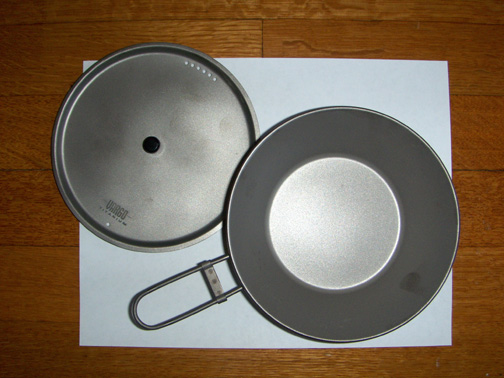 | | Pot and Lid |
Manufacturer: Vargo Outdoors, LLC
Year of Manufacture: 2008
Manufacturer's Website: www.vargooutdoors.com
MSRP: US $39.95
Listed Weight: 4.5 oz (128 g)
Measured Weight: 4.8 oz (136 g)
Component Weight:
Pot - 2.7 oz (77 g)
Lid - 1.7 oz (48 g)
Carry Bag - 0.5 oz (14 g)
(Totals do not add up to Measured Weight due to rounding)
Approximate Dimensions:
Lid Diameter - approx. 6 in (152 mm)
Base Diameter - approx. 3.75 in (95 mm)
Measured Volume - approx. 24 fl oz (710 ml)*
*Volume was measured by filling the Vargo Titanium Sierra 750 as full as possible with water, and pouring it off into a measuring cup.
INITIAL IMPRESSIONS
Upon opening the shipping box containing the Vargo Titanium Sierra 750 I found the product in a net bag with a tag which appears to be how the product is packaged for retail sale, as seen in the picture below.
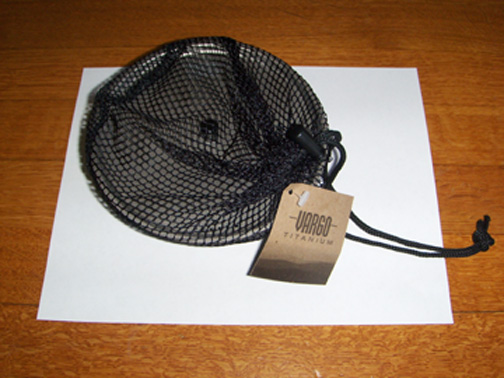 | | Vargo Titanium Sierra 750 As Received |
The net bag that serves as the product's carry case uses a drawstring closure with a toggle to keep it closed. My immediate thought on looking at the bag was that it seemed a little larger than necessary, and that a smaller cord and toggle would shave a few fractions of an ounce. It appeared, however, quite utilitarian.
I opened the net bag and removed the Sierra 750 and looked it over. My immediate thought was "do you call this a cup or a pot?" The design reminded me of an oversized sierra cup with a handle that folds out, but is smaller than any pot I've ever used. Given the way I intend to use it during testing, I will refer to it throughout this report as a pot. It appears that, with the exception of the lid handle and the screw that holds it in, the entire pot is made of titanium.
To extend the handle I pinched the wire that forms the handle together, allowing it to swing between the ends of the clip that locks it into the open or closed position. After opening the handle, I slid the spreader bar away from the end of the handle, thus locking it into place and preventing it from accidentally moving back into the closed position. The picture below illustrates the handle open, halfway to closed, and closed.
The design itself seems very simple and practical to me. It is substantially lighter than other cook pots I've used, even among titanium ones. Part of that is because of its size. The Sierra 750 is much smaller than most cooking pots I've used. I consider that a plus. On most backpacking trips my pot sees most of its use in heating water for coffee or tea, or preparing small meals for myself, such as ramen noodles for dinner. Looking at the Vargo 750, I realized it looked just about right for a single package of ramen. That makes it just about right for most cooked meals I would prepare on a solo trip, or any trip where I'm cooking only for myself. By following the profile of a sierra cup, the angle between the base and the sides is oblique, which will hopefully allow for easier cleanup.
 | | Vargo Titanium Sierra 750 Handle |
The design of the handle mechanism seems very simple, and reasonably stable. While the handle will move somewhat even in the open position, the spreader bar appears to lock the handle sufficiently that it will not collapse when full.
The lid of the Sierra 750 particularly impressed me. The handle is small, and held in by a screw on the bottom side of the lid. The outside edge is raised, allowing the lid to sit down slightly inside the main body of the pot. What I find truly ingenious, however, is the vent/drain holes. There is a single small hole on one side of the lid. Opposite this hole are six holes. These will allow me to drain items such as noodles and rice. My mind immediately turned to ways of reclaiming liquid from cooked meals (to use for hot beverages) to save on fuel weight over heating water separately for drinks.
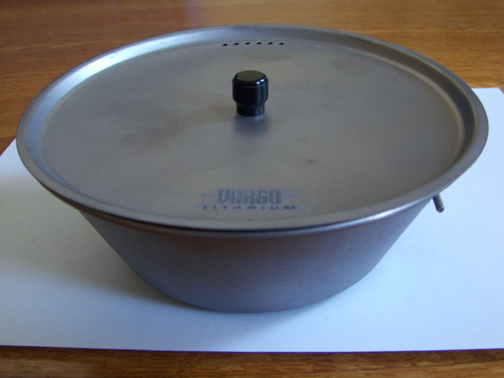 | | Lid on Pot |
After looking the Sierra 750 over closely, the only negative things I could find might be best described as relating to attention to detail in workmanship. The spot welds that hold the handle attachment to the pot itself are rather rough on the outside. The lid is not perfectly flat, and the entire pot had dark, smudged fingerprints all over it. These, however, do not concern me in the least, as they are entirely cosmetic. I mention them only because some people might find these to be a concern.
READING THE INSTRUCTIONS
No instructions were provided with the Vargo Titanium Sierra 750, and given the simple design, I do not consider them necessary.
TRYING IT OUT
In addition to the description of opening and closing the handle provided above in "Initial Impressions," I also used the Vargo Titanium Sierra 750 to prepare a package of ramen noodles on my kitchen range, to assess it's suitability for such a task. Before doing so, I ran it through my dishwasher, and all the fingerprints mentioned above came right out.
I prepared my ramen in my usual method while backpacking. I broke up the noodles into tiny pieces, and poured them in the pot. Much to my surprise, the pot was slightly less than half full with one 3 oz (85 g) package of ramen noodles. I think it may be possible to cook two packages of ramen in the pot simultaneously, something I will try during field testing. I covered the noodles with water, put the lid on the pot, placed the pot on the burner, and turned it up to high.
Within a few minutes the water had come to a boil. I will watch closely during field testing to see if cooking times are longer or shorter than I find with other cookware, but this kitchen test leads me to believe there won't be any major differences.
I removed the pot from the range, and took it to my sink to try out the draining holes. Holding the small handle on the lid to keep the lid from falling off, I tilted the lid. The drain holes worked very well, and in no time the noodles were drained. I added the seasoning from the seasoning package, stirred, and enjoyed my noodles.
One thing I noticed immediately is that the pot makes a lot of noise when using metal utensils. I use a polycarbonate spork while backpacking, so hopefully that will solve the problem. It wasn't just a little noisy, but rather I found it annoyingly loud.
After eating, I took it to my sink, and used my usual backpacking cleanup protocol: a little water and my thumb. It cleaned up passably with very little effort.
TESTING STRATEGY
I will be using the Vargo Titanium Sierra 750 as my only cooking pot for all my backpacking trips during the test period. I will use it primarily for heating water and simple meals such as ramen or rice, and it will serve both as cooking pot and bowl. It will see most, if not all, of its service in conjunction with a homemade sideburner pop-can alcohol stove. It will also be pulled into service for any other purpose it may seem suitable for at the time.
SUMMARY
Overall, the Vargo Titanium Sierra 750 appears to be a very well-designed cooking pot. While it is small, it is also exceptionally light weight, a trade I'm more than willing to make. While the absence of any non-stick coating allows me to use metal utensils without fear of damaging a coating, it is quite noisy when you're scraping the last few noodles out with a metal spoon. Cleanup does not appear to be a problem, though field testing will likely provide more challenging cleanup tasks.
FIELD REPORT
FIELD LOCATIONS AND CONDITIONS
I have used the Vargo Titanium 750 on 4 backpacking nights during field testing. It has been used in conjunction with a homemade pop can alcohol side-jet stove, and has been used to heat water for morning and evening beverages (coffee and tea) as well as to cook ramen and instant rice dishes.
All trips have been in the Olympic Mountains or along the coast of Washington, with elevations ranging from sea level to 1,500 ft (450 m). Temperatures on these trips have ranged from as high as 80 F (27 C) to as low as 28 F (-2 C), with the pot being in use during temperatures ranging from 28 F (-2 C) to 65 F (18 C). Winds have ranged from dead calm to coast breezes around 15 mph (24 kph). One evening while cooking I experienced light rain.
PERFORMANCE IN THE FIELD
Overall, I'm very, very pleased with the Vargo Titanium Sierra 750. The key factors I've focused my attention on during field testing have been general performance, durability, and ease of cleaning.
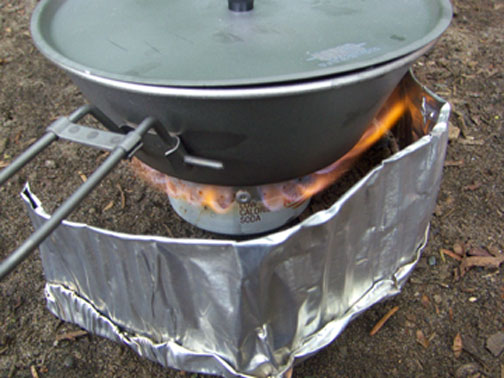 | | Flames curl up sides with sidejet stove |
Regarding the Titanium Sierra 750's general performance, I'm very pleased. Heating efficiency was my primary concern in performance. I had some concerns at first that the flames from my homemade side-jet alcohol stove might overshoot the small diameter bottom of the pot and make for inefficient heating. The stove I use serves as its own pot stand, thus the pot is placed directly on it and the flame jets out 21 small holes around the outside of the stove. The flames do, in fact, curl around the bottom edge, but that hasn't posed a performance problem. In fact, whether it is due to the design or the titanium material used, it performs better than other pots I have used in terms of boil time. I have successfully brought two cups (.47L) of water to a rolling boil in it in light winds with no windscreen. This is something I have never been able to do in other pots I've owned (normally I could get the water hot, but not boiling, given the fuel capacity of the stove). While I haven't conducted any timed studies, it's clear to me that I can boil water faster in this pot than either the aluminum or stainless steel pots I've used with the stove in the past. When there is no wind, the flame jets from my stove curl right around the bottom edge of the Titanium Sierra 750, traveling about halfway up the side. While I'm not an expert in thermal conductivity or stove design, my experience is that this works exceptionally well in terms of heating water rapidly.
Aside from heating performance, I've had not performance problems whatsoever with the stove. The drain holes in the lid come in very handy when I want to, for example, just estimate the water used to cook rice. I've found I now just throw in my rice with a bunch of water, and easily drain off whatever is left. I also have used the drain holes to drain ramen noodles. The only concern here is that the handle for the lid is very small and my fingers are pretty big, so scorching my fingertips is always a concern. I have found it simple in most cases to simply push down with one finger on the lid handle, and then turn the whole thing to drain. So far I haven't had any burnt fingers.
I will note that it is possible to cook two packages of ramen noodles at the same time in this pot, at least the way I usually cook them. I usually prepare my noodles by breaking them into small pieces, covering with water, and bringing to a boil (or close to a boil). I usually also pick out any larger clumps before adding the water and eat them dry while I'm waiting, so it's not quite two full packages. I do this mostly because I like the seasoning flavor to be a little stronger than with a full pack. After they're cooked I drain off most of the water, and stir in the seasoning packets. The tricky part in doing two packages at once in this pot is stirring in the seasoning packets with the pot relatively full. I don't cook my noodles long, so they don't swell much (I like them fairly firm). I usually stir fairly vigorously to get the seasonings well mixed, and with a full pot (if I cook the noodles longer than normal) it can be hard to stir vigorously without spilling noodles.
One added performance bonus from my perspective is that the lid makes a decent surface for lighting "strike anywhere" type matches. These are what I prefer to light my stove with. While usually I can find a handy rock to strike matches on, that's not always possible in the rain, and striking two match heads together often damages the heads. While it usually takes several passes to rough up a spot to get the match to light, and it can be a little tricky at times, I've not yet failed to get a match to light against the lid, and after it is lit, the lid serves as a handy rain and wind shield for the burning match.
Regarding performance of the pot handle, it still works as good as ever. Though it doesn't latch smartly into place, the amount of play that is left isn't bothersome to me now that I'm used to it. It actually seems more secure to me when the pot is full, as the weight of the contents keeps pressure on the handle assembly.
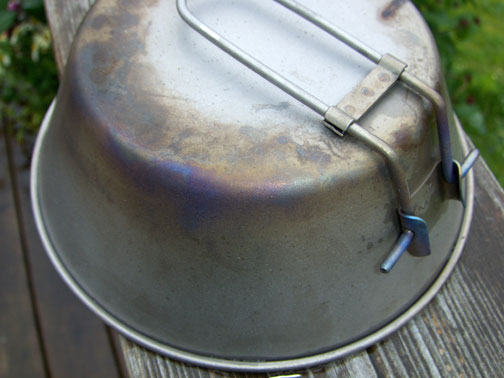 | | Minor heat discoloration on bottom and handle connection |
Durability, likewise, has not been a problem. No signs of fatigue or wear are present. There is some heat discoloration of the bottom due to direct contact with the flames from my stove, but this does not seem to impair performance in any way. I've not abused the pot in any way, but I haven't babied it either. So far it has been rugged enough for the normal abuse a pot sees from my in being stuffed in my pack, dropped on the ground, etc..
While I am not usually a stuff sack person, I have found myself using the stuff sack with this pot. I store my stove and matches, and sometimes fuel, inside the pot, and the stuff sack helps keep the lid against the pot. The stove seems to offer excellent protection to my somewhat fragile pop can stove. When the lid has shifted off the pot, the stove has remained in place and protected, and the stuff sack has caught my little bag of matches.
Regarding ease of cleaning, I've not had any problem with any foods sticking so bad that I couldn't remove them with a little elbow grease. Usually I'm not a stickler for cleaning while I'm on a trip, being satisfied when all visible remains of food are removed. I prefer bare metal over coatings in most cases, as I tend to abuse and wear through coatings fairly quickly. As far as bare metals go in terms of cleaning, this certainly hasn't been any more challenging than others I've encountered. I have yet to burn any rice or ramen on to the pot, however.
SUMMARY
The Vargo Titanium Sierra 750 is a simple, lightweight, and very effective pot for my typical use. It works better with my homemade pop can side-jet alcohol stove than any other pot I've ever tried. It has proven itself reliable, relatively easy to clean, and ideally sized for my normal use. An added bonus is that the top of the lid is just rough enough to strike a "strike anywhere" match on, once I got the hang of it.
TESTING STRATEGY
I plan to continue to use the Vargo Titanium Sierra 750 on all my remaining trips during the test period. I hope to try it with meals other than my usual "just boil water" menu as well.
I would like to thank Vargo Outdoors, LLC and BackpackGearTest for the opportunity to test this product. My long-term report will be appended to this report in approximately two months from the date of this report. Please check back at that time for additional information.
LONG-TERM REPORT
LONG-TERM TEST LOCATIONS AND CONDITIONS
During the long-term test period, I have used the Vargo Titanium Sierra 750 to cook morning and evening meals, and once as an impromptu shovel. I used the pot on a 3-night coast trip and two 2-night weekend trips during the long term testing period. All trips were in the Olympic Mountains or the Olympic Coastal Strip of Washington State. Elevations ranged from sea level to 4,200 ft (1280 m). Temperatures ranged from 35 F (2 C) to 90 F (32 C).
PERFORMANCE IN THE FIELD
The Vargo Titanium Sierra 750 has continued to perform very well. While most of my meals have continued to be simple instant meals (like instant rice or ramen) I have also cooked old-fashioned oats in the pot, and it functioned very well for the purpose. I wouldn't be afraid to try cooking anything in it that would fit.
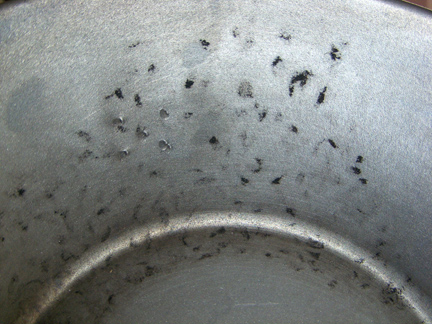 | | Black Marks from Burned Ramen |
The biggest thing I have learned during long-term testing is how difficult it is to clean the pot after severely burning a meal in it. One evening along the coast I was cooking ramen and not paying very close attention, and subsequently severely burned the ramen. While I'm not certain, I would estimate it continued to cook for probably 5 minutes after all the water had been absorbed and/or boiled off. It was scorched black against the pot, and was a dark brown fading to normal ramen color about ½ in (1.3 cm) in from the pot itself.
Cleaning the pot was a chore. I've burnt food just as severely on other cookware, and would say the difficulty in cleaning fell somewhere between poorly seasoned cast-iron and stainless steel in terms of difficulty cleaning. Using coarse wet sand, elbow grease, and about 20 minutes of my time I was able to get the pot passably clean. The spots where the noodles had been touching the titanium left black scorch marks, giving the inside as speckled appearance. I have not attempted to remove them with steel wool, but suspect I could get rid of the bulk of them in this manner, since scraping a fingernail across them does seem to lighten them. They aren't impacting the flavor of food, however, so I'm just leaving them as they are.
The only other unpleasant experience I've had was almost burning my hand once when I went to lift the pot off my stove. Without thinking, I had placed the handle on the downwind side of the stove, which allowed the flames to heat it. I ended up using my bandanna as a potholder, and started paying better attention to where the handle was in relation to the flames.
I am very impressed at how cool the rim of this cup stays when drinking a hot beverage. The handle is a little awkward for use as a cup, but since I use it primarily as a pot and dish, I don't mind it at all.
I've also used the pot for digging a cat hole, and would add it makes a passable shovel in soft soils. I questioned how it would do for this purpose, given that it is fairly flexible (it can be flexed slightly with my hands), and though it flexed, it got the job done.
SUMMARY
Overall, the Vargo Titanium Sierra 750 pot is a delightfully minimalistic and lightweight addition to my pack. It has served me well as both a pot and a cup, and even passed as a makeshift shovel on one occasion. It can, however, be a real challenge to clean if I severely burn something in it. It is sized well for trips where I am only preparing meals for myself, and is easy to maintain under normal conditions with a minimum of effort. It is sized and shaped in a manner that works exceptionally well with my homemade sidejet pop can alcohol stove.
CONTINUED USE
On trips where I'm preparing meals only for myself, this is the only pot I will reach for in the future. It's the perfect combination of light weight and utilitarianism for my purposes.
This report was created with the BackpackGearTest.org Report Writer Version 1.
Copyright 2008. All rights reserved.
Read more reviews of Vargo Outdoors gear
Read more gear reviews by Mike Curry
|




